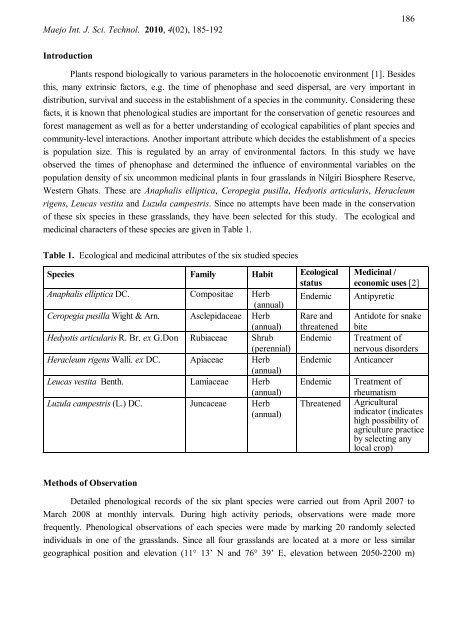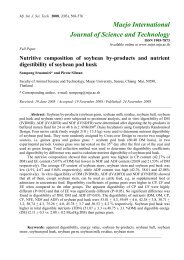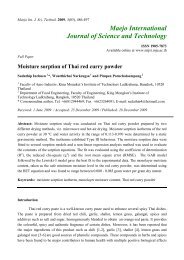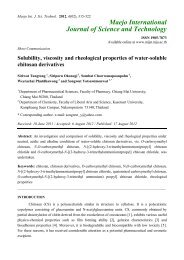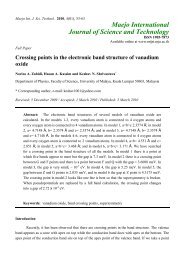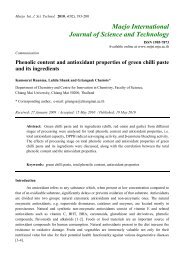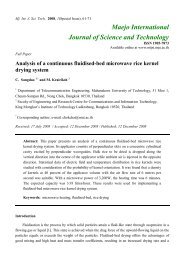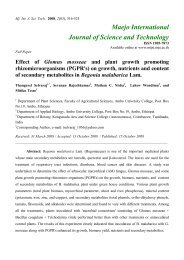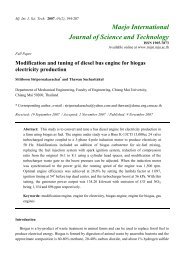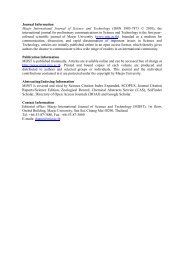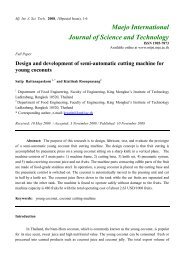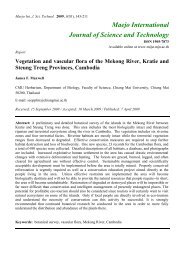Phenological observation and population dynamics of six ...
Phenological observation and population dynamics of six ...
Phenological observation and population dynamics of six ...
You also want an ePaper? Increase the reach of your titles
YUMPU automatically turns print PDFs into web optimized ePapers that Google loves.
Maejo Int. J. Sci. Technol. 2010, 4(02), 185-192186IntroductionPlants respond biologically to various parameters in the holocoenotic environment [1]. Besidesthis, many extrinsic factors, e.g. the time <strong>of</strong> phenophase <strong>and</strong> seed dispersal, are very important indistribution, survival <strong>and</strong> success in the establishment <strong>of</strong> a species in the community. Considering thesefacts, it is known that phenological studies are important for the conservation <strong>of</strong> genetic resources <strong>and</strong>forest management as well as for a better underst<strong>and</strong>ing <strong>of</strong> ecological capabilities <strong>of</strong> plant species <strong>and</strong>community-level interactions. Another important attribute which decides the establishment <strong>of</strong> a speciesis <strong>population</strong> size. This is regulated by an array <strong>of</strong> environmental factors. In this study we haveobserved the times <strong>of</strong> phenophase <strong>and</strong> determined the influence <strong>of</strong> environmental variables on the<strong>population</strong> density <strong>of</strong> <strong>six</strong> uncommon medicinal plants in four grassl<strong>and</strong>s in Nilgiri Biosphere Reserve,Western Ghats. These are Anaphalis elliptica, Ceropegia pusilla, Hedyotis articularis, Heracleumrigens, Leucas vestita <strong>and</strong> Luzula campestris. Since no attempts have been made in the conservation<strong>of</strong> these <strong>six</strong> species in these grassl<strong>and</strong>s, they have been selected for this study. The ecological <strong>and</strong>medicinal characters <strong>of</strong> these species are given in Table 1.Table 1. Ecological <strong>and</strong> medicinal attributes <strong>of</strong> the <strong>six</strong> studied speciesSpecies Family Habit EcologicalstatusAnaphalis elliptica DC. Compositae Herb(annual)EndemicCeropegia pusilla Wight & Arn. Asclepidaceae Herb Rare <strong>and</strong>(annual) threatenedHedyotis articularis R. Br. ex G.Don Rubiaceae Shrub Endemic(perennial)Heracleum rigens Walli. ex DC. Apiaceae Herb Endemic(annual)Leucas vestita Benth. Lamiaceae Herb Endemic(annual)Luzula campestris (L.) DC. Juncaceae Herb Threatened(annual)Medicinal /economic uses [2]AntipyreticAntidote for snakebiteTreatment <strong>of</strong>nervous disordersAnticancerTreatment <strong>of</strong>rheumatismAgriculturalindicator (indicateshigh possibility <strong>of</strong>agriculture practiceby selecting anylocal crop)Methods <strong>of</strong> ObservationDetailed phenological records <strong>of</strong> the <strong>six</strong> plant species were carried out from April 2007 toMarch 2008 at monthly intervals. During high activity periods, <strong>observation</strong>s were made morefrequently. <strong>Phenological</strong> <strong>observation</strong>s <strong>of</strong> each species were made by marking 20 r<strong>and</strong>omly selectedindividuals in one <strong>of</strong> the grassl<strong>and</strong>s. Since all four grassl<strong>and</strong>s are located at a more or less similargeographical position <strong>and</strong> elevation (11 13’ N <strong>and</strong> 76 39’ E, elevation between 2050-2200 m)


